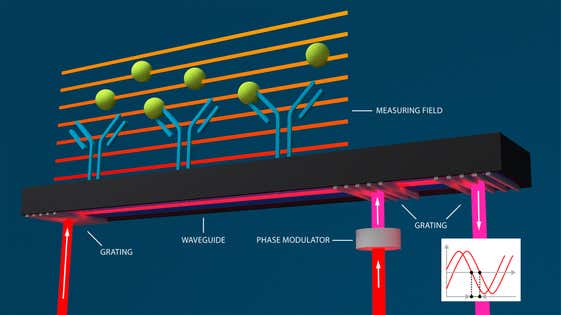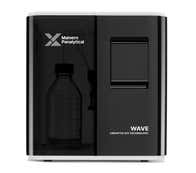Binding affinity and kinetics
Essentially, a sensor is a device that measures physical changes and converts these into a detectable output (e.g. a change in electrical current). Let’s explore what sensors and biosensors are with some simple examples.
The change can be in the environment. A good example is the temperature sensor your fridge. As the temperature increases, the resistance changes. It means that when the temperature becomes too high, the sensor will let the current pass through and activate the cooling system.
The change can also take place when a sensor is exposed to a sample. One example is a pH meter that measures a change in current when dipped into a sample and gives a read-out of the pH of the sample. In a biosensor, the sensing component is of biological origin (e.g. an antibody) and senses a change (e.g. binding of an antigen) and this change is converted into an output that can be detected (e.g. a change in intensity of the light source).
A biosensor is a device that detects chemical reactions where the sensing compound – an antibody, enzyme or nucleic acids – is of biological origin. This biosensing compound interacts with the sample (the analyte). In an optical biosensor, the interaction results in a change between the incoming and outgoing light source. This optical change is detected by a detector. Optical biosensors are powerful analytical instruments to measure biomolecular interactions in real-time, label free. Binding affinity and kinetics can be measured with high sensitivity.
Many optical biosensors have microfluidics, meaning that there is an alternating flow of buffer and sample in the system. In an experiment, one of the interactants is immobilized to the sensor surface (the ligand), the other is free in a solution that’s passed over the sensor surface (the analyte).
Image right: The schematics of a GCI optical biosensor
An optical biosensor with microfluidics is extremely sensitive and can measure biophysical interactions through label-free quantification. Techniques that are not label-free require labeling of the components to get an output that can be detected (for example, fluorescent labeling). These labeled technologies utilize labeled isotopes, fluorescence labeling, and radiolabeling which tends to modify the physicochemical or binding properties, making accurate interaction analysis difficult. Moreover, labeling might alter the ligand structure and/or function which could affect the experimental results. In addition, optical biosensors measure the interaction in real time, providing accurate data on the kinetics of the interaction. Techniques such as ELISA assays only provide the end-point measurement.

Optical biosensors can provide real-time, label-free binding affinity and kinetics. Analysts can directly measure the real-time interaction between molecules, including each stage of association, equilibrium and dissociation, and this provides deeper insight into both the affinity and kinetics of the interaction. From drug discovery to research, binding kinetics is relevant at for many applications, including:

Next-generation bioanalytical instruments for drug discovery and life scien...
Built upon the proprietary GCI technology, analysts can directly measure the real-time interaction between molecules, including each stage of association, equilibrium and dissociation, and this provides deeper insight into both the affinity and kinetics of the interaction. From drug discovery to research, binding kinetics is relevant for many applications, including WAVEcontrol and waveRAPID software to enable superior data analysis while maintaining throughput.
At the same time, the WAVEchip®, our no-clog microfluidic cartridge, supports a wide range of sample types and sizes. The WAVEsystem, a Creoptix technology, comes with a temperature-controlled autosampler that fits vials, and two 96- or one 384-well plates for further ease of use. Overall, the system gives you an unparalleled platform for real-time label-free binding kinetics:

WAVEsystemNext-generation bioanalytical instruments for drug discovery and life sciences for both industry and academic research |
|
|---|---|
| Measurement type | |
| Binding affinity | |
| Binding kinetics | |
| Label-free analysis | |
| Technology | |
| Grating-coupled interferometry (GCI) | |
| Microfluidics |